Reviewing methods for measuring carbon dioxide uptake, permanence
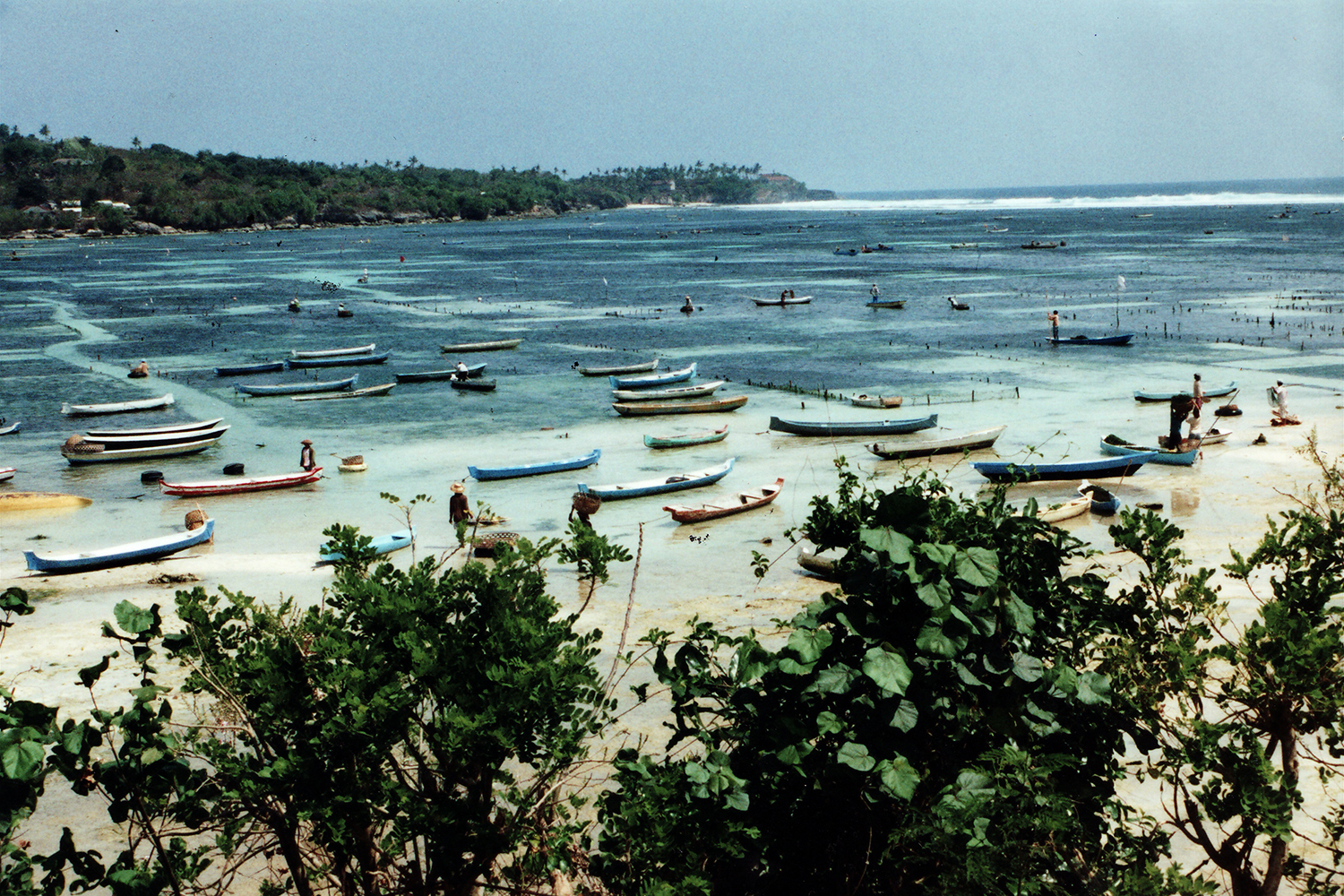
Carbon dioxide removal (CDR) is gaining recognition as a necessary action to prevent some of the most severe effects of climate change due to greenhouse gas emissions. CDR technologies can leverage technological pathways to capture or convert carbon dioxide (CO2), or biological pathways that rely on photosynthesis to fix CO2 into other forms of carbon. CO2 is present in and can be removed from either the air or the ocean to satisfy CDR goals. Marine CDR (mCDR) refers to the removal of CO2 from anthropogenic activities that has dissolved into the ocean.
Excess CO2 in the ocean lowers the pH of the seawater, resulting in ocean acidification, which can reduce calcification rates in shell-building organisms and corals, with far-reaching negative environmental and economic consequences.
In addition to restoration or preservation of natural blue carbon ecosystems like tidal marshes, seagrass meadows, mangrove forests and others, many mCDR methods – such as electrochemical methods, alkalinity enhancement, enhanced weathering, aquaculture and more – are being explored to mitigate the effects of climate change and ocean acidification.
The use of macroalgae cultivation to capture carbon through photosynthesis and sequester it in the deep ocean, sediments, or long-lived products is a promising and priority mCDR strategy, with relatively low costs and high potential for social and environmental co-benefits. However, there are significant challenges to measuring carbon capture and permanence of sequestration in macroalgae. The actual potential of large-scale macroalgae cultivation for carbon sequestration purposes is still unknown, especially considering variability between species, future changes in climate and biophysical limits to growth.
At present there are no established monitoring, reporting, and verification (MRV) protocols for assessing carbon capture and sequestration in macroalgae products or end uses. To understand the potential of macroalgae aquaculture as a mCDR strategy, it will be important to understand both the quantity of carbon captured (“uptake”) and the duration that the carbon will be sequestered (“permanence”), considering interactions across the carbon cycle and life cycle of a product instead of assuming permanent sequestration without sufficient data.
This article – adapted and summarized from the original publication (Rose, D.J. and L.G. Hemery. 2023. Methods for Measuring Carbon Dioxide Uptake and Permanence: Review and Implications for Macroalgae Aquaculture. J. Mar. Sci. Eng. 2023, 11(1), 175) – reviews methods for monitoring CO2 capture and sequestration across a variety of applications in various settings to identify potential applicability for macroalgae CDR monitoring and carbon accounting.
Study setup
This review conducted a structured literature search using Web of Science with the following keywords: “marine carbon dioxide removal” OR “ocean carbon dioxide removal” OR “ocean-based carbon” OR “carbon monitoring” OR “ocean deacidification” OR “blue carbon sink” OR “ocean carbon sequestration” OR “marine carbon sequestration”; and another search for “kelp” OR “seaweed” OR “macroalgae” (All Fields) AND “carbon dioxide” OR “carbon sequestration” OR “blue carbon” (All Fields) and “monitor” OR “measure” OR “assess” OR “evaluate” OR “method” (All Fields).
A total of 1,008 search results were returned and reviewed by a single person for relevance, out of which 479 were retained after review of title and removal of duplicates, and 382 remained after review of abstracts (complete collection available on request). A total of 382 papers were retained in the review that included information on monitoring carbon across a variety of CDR methods and contexts.
Monitoring methods ranged from simple sensors (for pH, dissolved inorganic, or organic carbon and sampling routines to complex models coupled with remotely sensed data). Methods can be grouped into three general categories of application: monitoring carbon uptake, methods for monitoring carbon permanence and comprehensive frameworks for analyzing carbon capture.
For detailed information on the survey, data collection and analysis, refer to the original publication.
Limitations of existing methods and applicability to macroalgae aquaculture
Numerous methods exist for measuring the carbon uptake in macroalgae, so the choice of tools for monitoring CDR at a farm depends more on costs, access, and harvest practices. Remote sensing via satellite or aerial vehicles has been used more for species identification or basic areal mapping, without taking a next step to carbon assessment, though estimations could be applied.
Physical sampling methods vary greatly in terms of cost and design to estimate carbon uptake, especially if underwater work is required at depth. However, for cultivated macroalgae, it is easy to predict carbon content in a harvest based on modeled estimates of biomass, which can then be confirmed by weighing at harvest.
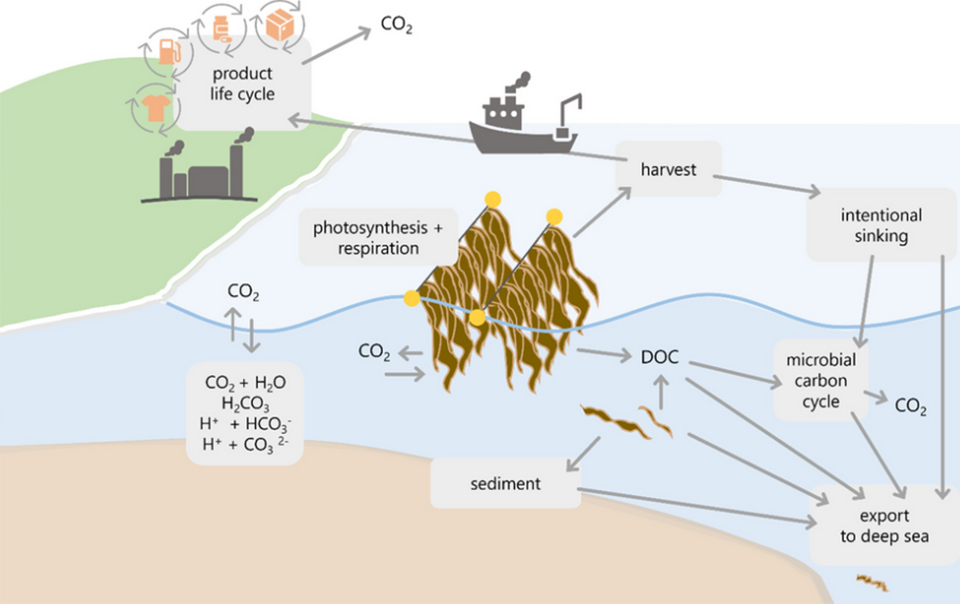
Like other blue carbon habitats, macroalgae serve at least as a short-term CO2 sink, fixing more carbon than is respired over a growing season. However, for the carbon in macroalgae to be permanently sequestered, it must be exported to anaerobic sediments, calcified (coralline macroalgae only), sunk (either deliberately or naturally), or converted to a long-lived carbon-containing product.
Many products can be made from harvested macroalgae, including biofuels, textiles, building materials, food, fertilizer and more, but assessment of permanence requires consideration of the entire life cycle of the product and its carbon composition. At present, the permanence of carbon in macroalgae is assessed by sampling sediments under macroalgae aquaculture farms to estimate the fraction of carbon exported to the deep sea, and emerging combination methods for eDNA and isotopic analyses are promising to trace carbon flows and estimate sequestration on the seafloor. However, these methods only represent the carbon sequestered throughout the natural life cycle and exclude harvested product potential.
Comprehensive frameworks identified in the literature review attempt to assess the uptake and permanence of carbon in products and ecosystems, but they fall short in many cases. Life Cycle Assessments (LCAs) often define system boundaries to exclude end-of-life scenarios and are not designed to track carbon. As it is only one piece of a larger assessment, the carbon captured in macroalgae in the cultivation phase is represented simplistically, not clearly reported, or ignored on the assumption that all carbon captured will be released back into the atmosphere at the end of the product life.
Methods for valuing temporary storage
While permanent carbon removal is considered the highest value storage and durability is a key consideration in carbon credit markets, and is required for some corporate net-zero standards, many studies have highlighted the value of temporary carbon storage as it relates to mitigating climate impacts to increase the options available for offset purchases.
This could be an excellent arena for cultivated macroalgae, considering the life span of macroalgae while they are growing at a farm, the fraction that has demonstrated permanent sequestration in export to deep sea sediments, and the carbon transformed into products following harvest. Blue carbon trading markets are still merely hypothetical and understanding possibilities for a variety of sale methods and pricing structures will be needed to move toward the realities of adoption for cultivated macroalgae.
Matthews et al. explore the climate effects of nature-based solutions (specifically, land-based storage due to reforestation). Through a modeling approach, they found that temporary carbon storage could decrease the magnitude of global temperature increases when deployed on a large enough scale (on the order of 10.4 Gt CO2 per year) and coupled with ambitious emission reductions. This shows that carbon removal alone is not enough, but even semi-permanent approaches could add up to significant benefit. In addition, several other methods for valuing temporary carbon storage and for accounting for temporary carbon storage in LCAs of products have emerged in the literature.
In all these options for valuing the temporary storage of carbon in macroalgae, it should be emphasized that temporary storage alone is not enough to mitigate the effects of climate change. Rapid decarbonization and emissions reductions are necessary alongside a variety of carbon removal methods to prevent further negative effects of global climate change due to decades of unchecked anthropogenic emissions. Realistic, rigorous assessment of the potential for macroalgae to contribute to either permanent or temporary carbon removals is needed to avoid the sale of questionable carbon credits that do not represent real outcomes.
Considering non-carbon benefits of macroalgae aquaculture
While the carbon capture and sequestration potential of macroalgae is a key focus of this review, there are many additional benefits provided through cultivation that should be noted.
Macroalgae remove nitrogen and phosphorous from the water, provide habitat functions (even in cultivated longlines), protect other cultivated or naturally occurring species from ocean acidification, and can generate valuable products that support coastal communities, including food, and could even have further carbon sequestration benefits (e.g., biochar as a soil amendment or bioenergy with carbon capture and storage). Switching from fishing pressure to macroalgae farming can help restore ecosystems, retain traditional values, and increase gender equity in the ocean food industry.
In some cases, monitoring carbon uptake and permanence at macroalgae farms could go together with monitoring additional environmental impacts or benefits. In particular, ecosystem services assessment is one way to identify and assess both the carbon value and these additional values. Life Cycle Assessments can also be applied to assess additional impacts as well as benefits in the processing or product phases, for example, nitrogen and phosphorus are often already considered in metrics for eutrophication.
Several private companies already have efforts underway to explore the possibility of sinking large quantities of kelp or seaweeds for the purposes of carbon sequestration. Sinking is just one of many uses for cultivated macroalgae, and many other products or uses could contribute to carbon removal efforts with additional co-benefits. Or simply restoring natural marine ecosystems is another approach to be explored, mirroring terrestrial restoration efforts that currently have MRV protocols and for which carbon credits can be issued. Long-lived products made from macroalgae, such as building materials, extracts like alginate that can be used in cement, and textiles could also sequester carbon on significantly permanent time scales, while generating profits.
Considering the costs and feasibility of these options is an emerging area of research that will become increasingly relevant in terms of voluntary or involuntary carbon markets. The further development of methodologies for assessing the potential of these alternative efforts is needed to minimize cost and maximize the overall value that can be gained from farming the ocean to remove CO2, as part of global efforts to develop and deploy innovative climate solutions.
Perspectives
In this review, we identify methods for monitoring carbon uptake and permanence in various contexts and discuss the possible opportunities and limitations as applied to cultivated macroalgae. Monitoring carbon uptake is necessary to understand the quantity of carbon removed from the marine environment while monitoring carbon permanence is needed to understand the duration of the carbon removed to assess the resulting effect on the global carbon cycle and ultimately climate change mitigation.
While numerous methods exist and are utilized to measure carbon in the ocean and on land, the research community has yet to coalesce around a unified approach or set of methods. There is a clear need to continue to pursue and test novel methods of tracing the flow of carbon in macroalgae systems, learn from other contexts, combine multiple methods, and leverage existing frameworks and tools to move toward a comprehensive understanding. In particular, methods to assess the permanence of carbon in the natural life cycle of macroalgae and the permanence in products following harvest need to be more fully developed.
Although it is clearly documented that macroalgae have many co-benefits in addition to carbon sequestration, this review reveals that there are many unknowns when it comes to assessing the permanence or climate mitigation potential of the captured carbon. Until the carbon sequestration potential of cultivated macroalgae is fully documented and verified, the research community would be remiss to promise climate benefits or sell carbon credits. As this is an active area of research, with many high-profile organizations involved globally, it will be important to realistically assess the carbon benefits from macroalgae cultivation to maintain accountability and comparability with other CDR methods.
The full benefits of macroalgae cultivation as an effective climate solution will only be achieved through collaborative research between private industry, governments, and academia to develop monitoring, reporting, and verification standards in addition to thorough methods for realistically assessing carbon uptake and permanence.
Now that you've reached the end of the article ...
… please consider supporting GSA’s mission to advance responsible seafood practices through education, advocacy and third-party assurances. The Advocate aims to document the evolution of responsible seafood practices and share the expansive knowledge of our vast network of contributors.
By becoming a Global Seafood Alliance member, you’re ensuring that all of the pre-competitive work we do through member benefits, resources and events can continue. Individual membership costs just $50 a year.
Not a GSA member? Join us.
Authors
-
Deborah J. Rose, M.M.A.
Corresponding author
Pacific Northwest National Laboratory, Coastal Sciences Division, Seattle, WA 98109 USA[118,111,103,46,108,110,110,112,64,101,115,111,114,46,104,97,114,111,98,101,100]
-
Lenaïg G. Hemery, Ph.D.
Pacific Northwest National Laboratory, Coastal Sciences Division, Sequim, WA 98382 USA
Related Posts
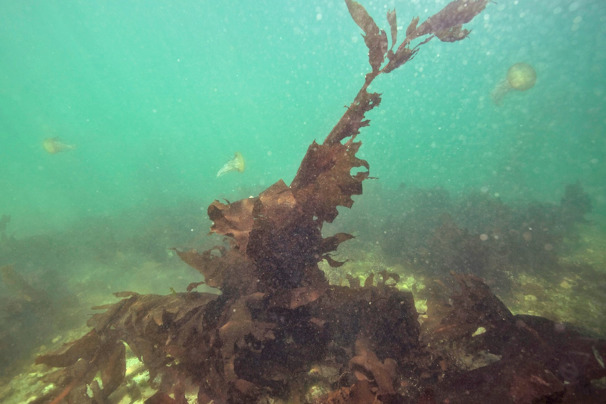
Aquafeeds
Assessing the effect of four macroalgae inclusions in diets of Pacific white shrimp
Evaluating macroalgae inclusions in L. vannamei diets show improved growth and intestinal microbiota and prevention of oxidative damage.
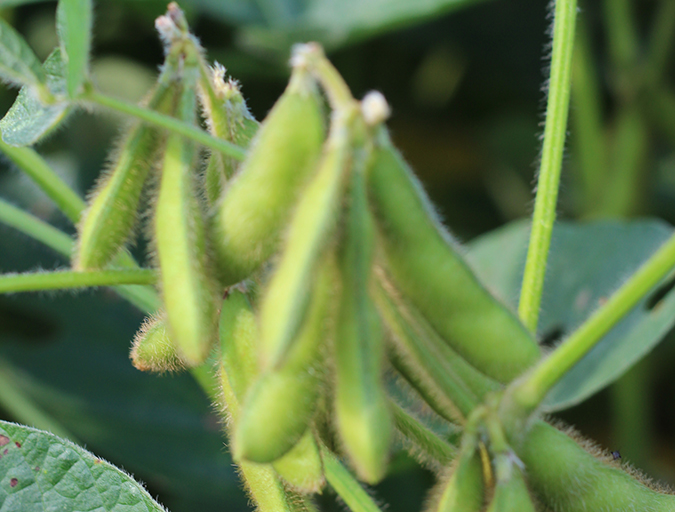
Intelligence
Omega-6s and the threat to seafood’s healthy halo
Research shows farmed fish fed diets heavy on vegetable oils have higher amounts of omega-6s and lower amounts of omega-3s, compared to fish fed diets heavy on fish oil. We take a deep dive into the relationship between the two fatty acids.
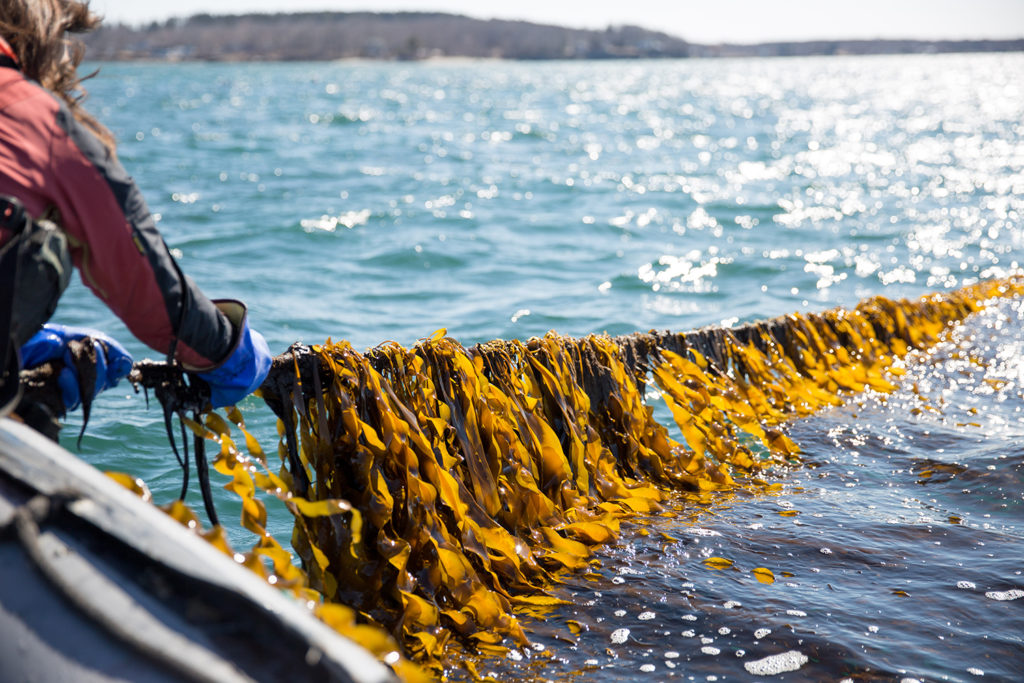
Intelligence
Kelp is the climate-friendly crop that could
Kelp aquaculture is poised for growth on both U.S. coasts, but one grower network in Maine is building a brand and demand for domestic seaweed.
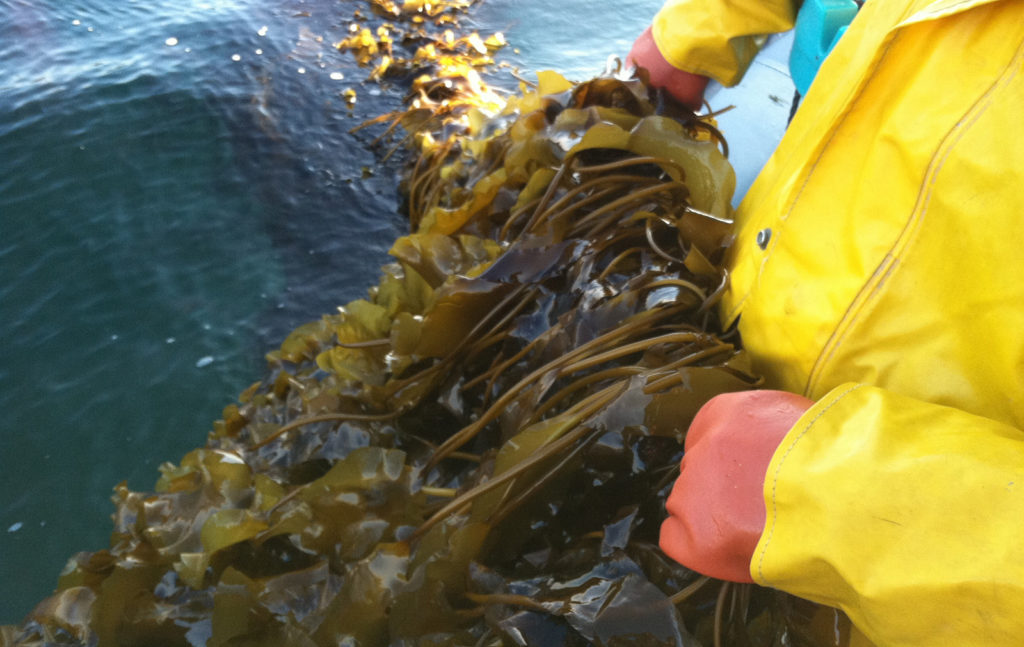
Responsibility
Lean and green, what’s not to love about seaweed?
Grown for hundreds of years, seaweed (sugar kelp, specifically) is the fruit of a nascent U.S. aquaculture industry supplying chefs, home cooks and inspiring fresh and frozen food products.



